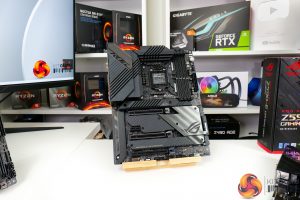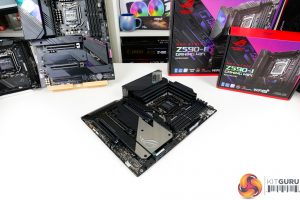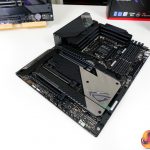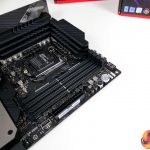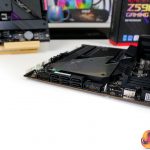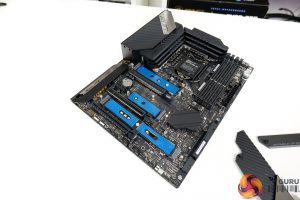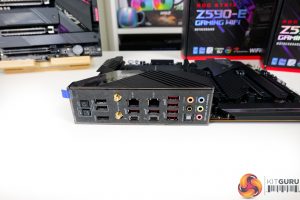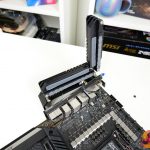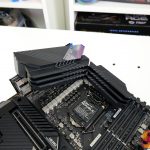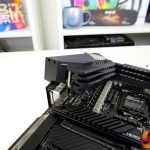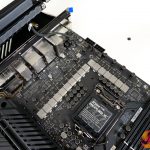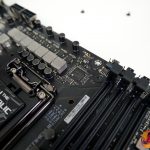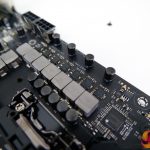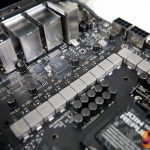Sitting a rung above the ROG STRIX Z590-E Gaming WiFi in ASUS’ product ladder, the Maximus XIII Hero is very similar to its cheaper brother in many respects but adds some more enthusiast and overclocking geared features. Notably, the power connectors are upgraded to dual 8-pin for higher total throughput capability.
You still get the same eight 4-pin fan headers, but greater space constraints around the CPU socket means that more header are distributed around the board. This is actually a slight downgrade for the Hero in my opinion. ASUS does, however, upgrade an additional header to 3A/36W output so now you get two of those. Greater focus is also put on liquid cooling, with the inclusion of Water IN, OUT, and Flow headers.
20Gbps USB 3.2 Gen 2×2 Type-C is the same but now you get two 5Gbps USB 3 internal headers instead of one thanks to the addition of an ASMedia ASM1074 hub. Both are right-angled which is good for cable tidiness but increases interference likelihood. Alongside the 2-digit debug LED and POST LEDs of the Z590-E Gaming WiFi, the Hero gets equipped with an onboard power button and a Flex Key button that is set as RESET by default. There is also a RETRY button at the bottom of the board.
Expansion slot configuration is largely the same for the Hero. This time, however, the lower full-length slot runs at PCIe Gen 3 x4 from the Z590 chipset by stealing lanes from four total SATA ports.
You still get four total M.2 slots and the configuration remains largely the same. One important change, however, is that M.2 slot 4 shares bandwidth with two SATA ports. This means that an SSD in M.2 slot 4 and an x4 expansion card in the lower PCIe slot will leave you with none of the six SATA ports usable. This is simply a limitation of the Z590 platform connectivity and is a decision by ASUS on deactivating the lower priority devices.
The M.2 heatsinks have also been beefed up slightly for the Hero. The top Gen 4 cooler features a multi-tiered slab of metal that should do a superb job. And the secondary slot’s heatsink branches out to the chipset RGB LED cover, giving it a little extra surface area … as well as a slightly more complicated installation procedure. No tool-less installation method like with the Z590-E Gaming WiFi is disappointing. The Hero does, however, offer dual-sided M.2 SSD cooling instead, so this is a clear functionality upgrade.
The Rear IO of the Hero is fantastic, once again offering an upgrade over the cheaper Z590-E Gaming WiFi. You get eight USB Type-A ports – 6x 10Gbps USB 3.2 Gen 2 and 2x old USB 2.0 ports including one which handles BIOS Flashback. Catering once again for enthusiasts, the Hero offers dual Thunderbolt 4 Type-C ports on the rear IO via an Intel JHL8540 controller. These are great inclusions if you have the need for TB4 connectivity as it is an area where the Intel platform currently makes sense versus AMD.
Once again we see, 2x Intel I225V 2.5GbE NICs and AX210 2×2 WiFi 6E support. Only full-sized HDMI 2.0 is available for dedicated video as both TB4 ports carry the DP 1.4/TB video link. The rear clear CMOS and BIOS flashback get proper buttons which is a minor upgrade. Once again, ASUS deploys a superb rear IO configuration.
The VRM heatsink is gargantuan and is even bigger and beefier than the Z590-E Gaming WiFi’s block. Again, we get multi-tiered slabs of metal connected via heatpipe. And the left-side heatsink still extended as the rear IO cover and RGB housing. ASUS’ effort with the VRM heatsink design here is very impressive. And clearly ASUS has confidence in the implementation as there is no included fan or fan mount.
The power delivery components also get an upgrade for the Hero. We see the same 17 stage total design split as 14+2+1. And we get the same high-quality Intersil ISL69269 PWM controller. This time, however, ASUS upgrades the 14 Teamed CPU VCore power stages to Texas Instruments 95410 which are rated at 90A. That gives a total theoretical power output of 1260 Amps for the CPU VCore. This board will push hard in even extreme OC situations. And cooling will not be a concern for general usage as the VRM will be under such light load compared to its specified capability.
The 3 non-CPU VCore power stages are downgraded to the slightly lesser performing 70A 59880 power stages from Texas Instruments. But that is completely fine! And still we see the inclusion of 5K-rated MIL capacitors. This is a particularly high-performance power delivery solution that will have no problem for sensible daily usage as well as being capable of extreme OC applications.
 KitGuru KitGuru.net – Tech News | Hardware News | Hardware Reviews | IOS | Mobile | Gaming | Graphics Cards
KitGuru KitGuru.net – Tech News | Hardware News | Hardware Reviews | IOS | Mobile | Gaming | Graphics Cards


